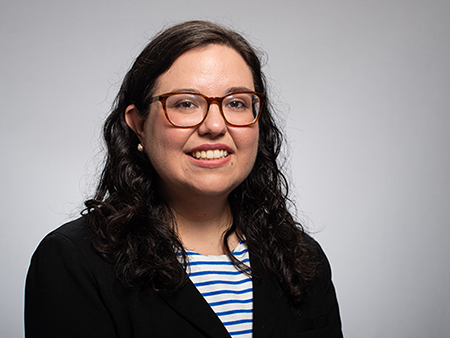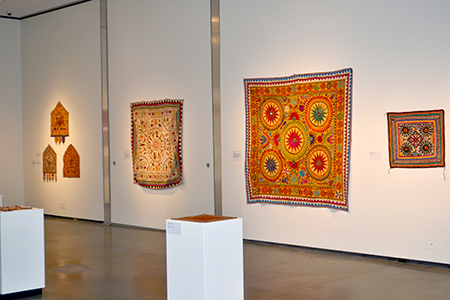 Amy WilliamsonAmy Williamson wears two hats at the Alabama State Council on the Arts, and she loves them both.
Amy WilliamsonAmy Williamson wears two hats at the Alabama State Council on the Arts, and she loves them both.
As a program manager, the University of Alabama at Birmingham alumna helps support artists and arts organizations with fellowship and grant applications. She works on fascinating “one-off” projects, such as helping tourism or the film industry identify talent or facilitating artist visits and lectures, and helps artists and groups grow and give back to Alabama communities. An area of her job she also really enjoys is interviewing artists for the “Alabama Arts Radio” show on Troy Public Radio.
As the gallery manager, she curates the Georgine Clark Alabama Artists Gallery in the ASCA headquarters in downtown Montgomery, Alabama. The gallery is perhaps one of the most forward-facing aspects of ASCA and engages nontraditional visitors who may encounter the gallery while running to the bank or lunch.
“I love highlighting Alabama’s talented visual artists, their unique perspectives and the inspiring work they create,” Williamson said. “The best part of both responsibilities is that I get to build relationships with talented artists and arts administrators across the state. I also get the chance to pay forward all the ways my UAB professors helped advance my career, by helping promote and fund Alabama artists and arts organizations. This is an incredibly rewarding and exciting opportunity.”
|
“I love highlighting Alabama’s talented visual artists, their unique perspectives and the inspiring work they create,” Williamson said. “The best part of both responsibilities is that I get to build relationships with talented artists and arts administrators across the state. I also get the chance to pay forward all the ways my UAB professors helped advance my career, by helping promote and fund Alabama artists and arts organizations. This is an incredibly rewarding and exciting opportunity.” – Amy Williamson |
Williamson, a Birmingham native, earned her Master of Arts degree in art history from the College of Arts and Sciences’ Department of Art and Art History in 2016. Williamson’s graduate research focused on women’s art collecting practices and museology. She was previously the fine arts assistant at the Hoover Public Library and interned at the Birmingham Museum of Art for two years. She also worked as public programs curator at the Alabama Department of Archives and History.
How did the MA program at UAB specifically prepare you for a career in the arts?
“While the MA program certainly prepared me by giving me the art historical knowledge required for the field, one of the highlights of the program for me was the opportunity to co-curate an exhibition with Dr. Cummings [UAB Associate Professor of Art History Cathleen Cummings, Ph.D.]. Working hands-on to mount a show — from planning to writing object labels and preparing the gallery — I gained firsthand curatorial experience that proved just as valuable as the knowledge learned during lectures.
“My instructors were very supportive of my thesis project and encouraged me to travel to several symposia and other lecture opportunities to build my public speaking skills. While this is clearly a very practical outcome, I appreciate my professors’ taking time to prepare me for the real world and a career in speaking to diverse audiences about the arts. I now give presentations on grant applications to artists and arts organizations statewide, a skill that was honed years ago at graduate student symposiums. I believe that, by working on both the critical knowledge and everyday skills, UAB helped make me more a well-rounded arts professional.
“As an aside, UAB’s faculty has won an astounding number of individual artist fellowship grants over the years, which fills me with immense pride.”
 WIlliamson was a co-curator on Cathleen Cummings' exhibition, "Objects of Authority: Contemporary Textiles from Western India" at UAB's AEIVA.Tell us about your thesis project, “The Ladies Who Founded MOMA: How Three Female Art Collectors Created One of the World’s Leading Museums.”
WIlliamson was a co-curator on Cathleen Cummings' exhibition, "Objects of Authority: Contemporary Textiles from Western India" at UAB's AEIVA.Tell us about your thesis project, “The Ladies Who Founded MOMA: How Three Female Art Collectors Created One of the World’s Leading Museums.”
“My thesis project grew out of a paper for one of my first classes at UAB, Modern and Contemporary Art to 1945, with Professor of Art History Heather McPherson, Ph.D. It was the first time in my life that I thought critically about the work that goes into amassing a collection of artwork and then creating a repository for those objects. Giving art collecting scholarly treatment, especially women’s collecting, is still a relatively new field of study, and I appreciate the attention to art historical trends paid by the faculty at UAB.
“I focused on Abby Rockefeller, Lillie Bliss and Mary Quinn Sullivan, each of whom was collecting modern art in the early 20th century. These three collectors pooled their resources and skills honed in ‘more suitable’ women’s organizations and clubs to found a museum geared toward showcasing this new type of art. They set out to do something new and daring — to create a museum that did not see itself as a permanent collecting repository as much as a gallery (with some limited collecting power) to showcase the latest and newest art styles. The final chapter of my thesis addressed how this mission fared in the years after the founders’ deaths and as the Museum of Modern Art navigates contemporary challenges, including a massive collection and changing visitor demographics and needs.
“For my thesis research, I was fortunate that in the early stages I could rely on MoMA’s digital archives and UAB’s interlibrary loan system. I remain grateful to the staff of the Mervyn Sterne Library for their help in securing resources during the initial research phases of this project. In the final months of writing my thesis, I traveled to New York City to visit MoMA’s archives. I spent a full workweek researching and reviewing the museum’s founding documents, initial plans and early exhibition catalogs. I was very fortunate that UAB supported this research project and helped me to attend conferences across the nation. During my time at UAB, I was awarded an Ireland Travel Grant, a Graduate Student Association Travel Stipend and the Klaus Urban Scholarship. This financial support enabled me to complete my research and to build a competitive resume.”
In light of your research, can you discuss what it means to be a woman working in the arts today?
“I have to say that the times are definitely more favorable for women working in the arts than they were for the women who founded MoMA in 1929. Rockefeller, Bliss and Sullivan felt they had to do much of their work in the shadows so that the proposal of such a museum would be taken seriously. In fact, they did such a good job of erasing themselves from the museum’s early narrative that a scholar 50 years later did not know of their role in founding MoMA, and had assumed the first director, Alfred Barr, was the museum’s sole founder.
“I will not say, however, that everything is perfect for women in any workplace. Gender biases can be found anywhere, including the arts. That said, I choose to focus on visibility as my metric for the changes since 1929. Now we see emerging research from the Andrew W. Mellon Foundation that women are the majority of those working in the field, at 61 percent of employees in art museums.
“In contrast, I briefly mention race at various points in my thesis, especially looking at how in 1929 Manhattan both race and gender were ‘disqualifiers’ for those seeking to navigate the art world. The Mellon Foundation report shows that the number of people of color working in the field is around 28 percent, with only 20 percent of curatorial, leadership or educational positions being held by people of color. To me, there is need for more racial diversity and inclusion in the arts; arts professionals must continue to strive to remove the class and socially constructed barriers that discourage more people of color from pursuing careers in this field.”
 Georgine Clark Alabama Artists Gallery in the ASCA headquarters in downtown Montgomery, Alabama.From your perspective, what is special about the arts in Alabama? And how do you plan to engage with the arts across the state as we celebrate the bicentennial and beyond?
Georgine Clark Alabama Artists Gallery in the ASCA headquarters in downtown Montgomery, Alabama.From your perspective, what is special about the arts in Alabama? And how do you plan to engage with the arts across the state as we celebrate the bicentennial and beyond?
“Something I find to be incredible about the arts in Alabama is the sheer diversity of mediums and styles. Growing up in Birmingham and receiving my formal education between Birmingham and Atlanta, I was missing an understanding of more vernacular and folk traditions. I have become much more aware of the art and artists living all around me as a result of this new position. Take Brenda Davis, who is a prolific outsider artist of international acclaim living fewer than 20 miles from Montgomery but is by no means a household name in her hometown. Conversely, internationally famous and well-known artists, like Nall, are also working here in Alabama. Alabama’s art scene is a melting pot: the celebrated and the “obscure,” the classically educated and the self-taught, and all points in between. Nationally, the conversations about Alabama’s art history are shifting too, with the Smithsonian American Art Museum’s Bill Traylor exhibition and Kerry James Marshall’s rise to the top of the contemporary art world; Alabama artists have demonstrated that important work and artists come from our state.
“One of the best parts of my job is getting to meet and visit with artists and arts organizations statewide. In the bicentennial year and beyond, I look forward to meeting with as many individuals and groups as possible so that I can better promote their activities for funding, as well as regional and national exposure and opportunities. I aim to be a cheerleader for Alabama artists and visual arts organizations and hope to support them in any and every way I am able.”